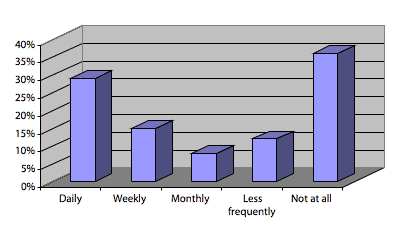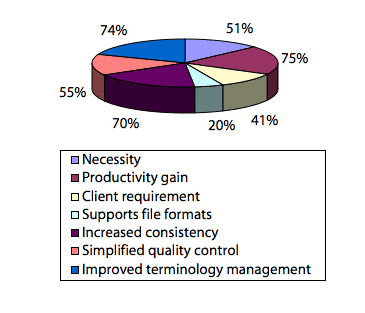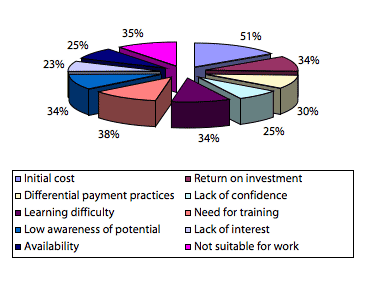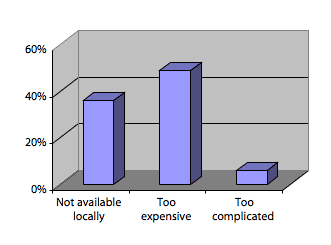 |
 |
 |
| Home | More Articles | Join as a Member! | Post Your Job - Free! | All Translation Agencies |
|
|||||||
|
|
eCoLoRe (eContent Localization Resources for Translator Training)
A Major Breakthrough for Translator Training
Both approaches to the TM issue are informative and complementary to one another. The LISA survey will be of primary interest to companies looking at defining long-term value and ROI of TM, while the eCoLoRe study will help individuals determine how best to use TM. Vendors especially will find value in the latter survey as it will help them understand how to better meet the needs of their present and potential users. Using the results of the two surveys in tandem will enable organizations to understand both the business and usability issues. They will then be prepared to make the best decisions regarding TM usage. The EU-funded eCoLoRe project, under the Leonardo da Vinci II program, commenced in November 2002 and is scheduled to run for three years. eContent localization is the translation and cultural adaptation for local markets of digital information. To be efficient, this relies heavily on specialized computer tools requiring intensive training. eCoLoRe aims to remedy a “severe skills shortage” by developing shareable materials that exercise tools for the localization of e-content generally. The materials will include both primary resources—such as translation memories, machine translation source-target pairs and terminologies—and scenarios for their pedagogic exploitation in realistic task-oriented situations. eCoLoRe targets trainers in academe, professional associations and industry, as well as university students and practicing translators. Targeting all official EU languages plus selected languages of New Acquisition States, the Consortium brings together leading representatives of those engaged in the dialogue about translator training. The eCoLoRe website will host these freely accessible resources and serve as a training forum for a virtual community of translators. The EC monitor is Bert Esselink, and principal partners are:
The initial kick-off meeting in Leeds, England in November 2002 introduced the partners and served to create a plan for the project. In March 2003 a progress meeting was held with all partners in Barcelona, Spain. The Barcelona meeting introduced three new subcontractors to the project: the University of Trieste, the University of Helsinki and ISTI (Institut supérieur de traducteurs et interprètes) in Brussels. Discussions ran on two tracks, with ITI and BDÜ focusing on analysis of a recent questionnaire, and the other partners reviewing progress on technical issues. Translation Memory Survey 2003One of the earliest objectives of the project was to create, disseminate and collate results from a detailed questionnaire. There was no pre-conceived notion of the expected volume or quality of response to the survey. As regards volume of response, this was considered to be quite low which in itself suggests a requirement for the eCoLoRe project. It would appear that lack of both interest and knowledge is a significant contributor to the current low level of use of new technologies and localization tools. The survey raised many important questions and has generated strong debate among translation professionals. The eCoLoRE project will focus on delivering awareness of the issues to tools developers, trainers and suppliers of the final products. A summary of the findings follows. ObjectivesThe central objectives of the survey were to identify and measure current TM usage, areas (languages and subject) of specific use, training requirements and issues, and reasons for using or not using TM. MethodologyThe survey was disseminated in the form of a questionnaire by ITI and BDÜ. Members of both institutes participated, along with language industry contacts from educational institutions and corporate businesses. It is estimated that through this process some 15,000 language industry professionals are now aware of the eCoLoRe project. The survey was available through web site, by email and in hard copy. Survey QuestionsThe questionnaire was created specifically to extract respondents’ experiences and concerns with TM tools. Questionnaire Findings1. General Information
Twenty-nine percent of the respondents used TM daily, 15% weekly, 8% monthly and 12% less frequently. Thirty-six percent said that they did not use TM products at all. (See Figure 1.) 
Figure 1. Frequency of Use of TM In terms of age, the majority fell within the ranges of 30-39 and 40-49 years, at 38% and 37% respectively. Forty-six percent said they had more than twelve years of translation experience. Twenty-seven percent had seven to twelve years, while 7% had less than three years. Of the types of text worked with, technical documentation led the field at 67%, followed by legal and economics texts at 62%, web-based information at 38% and software user interfaces at 37%. Help files accounted for 26% and literary texts 17%. The following subject domains were identified:
Asked about their target language, 78% of BDÜ respondents listed German, 32% English, 18% French and 11% Spanish. This partly reflects the BDÜ's multinational membership, but in some cases, respondents listed more than one target language. Eighty-two percent of ITI respondents listed English, 28% German, 23% French and 12% Spanish. With regards to source languages, 71% of BDÜ respondents cited German, 67% English, 34% French and 28% Spanish. ITI respondents listed English at 64%, German 53%, French 34% and Spanish 22%. Given that 36% of respondents said that they did not use TM products at all, while 29% said that they did so daily, how do the two groups differ, and do they have any features in common? Forty-three percent of the non-TM users were 30-39 years of age, and 36% were 40-49. Thirty-six percent had more than twelve years experience, and 39% seven to twelve years. Of the text types worked with, legal texts led the field with 63%, followed closely by business correspondence at 62% and economics texts at 61%. Literary texts accounted for 21%. Even so, 53% mentioned technical documentation and 16% software user interfaces. Why then are some translators deterred from using TM products? The reasons are examined below. In terms of age and experience, the profile of the 29% of BDÜ and ITI respondents who use TM products daily would not appear to differ significantly. Of those, 42% are aged between 40-49, 46% are between 30-39. Forty-three percent had more than twelve years experience, and 29% had between three and seven years. Only 3% had less than three years translation experience. Differences emerge, however, in the types of text translated. Seventy-six percent of the daily users, as compared with 52% of non-users, cited technical documentation, 58% software user interfaces, and 43% help files and web-based information. Not surprisingly, only 4% mentioned literary texts, compared with 27% in the non-user group. 
It would therefore appear that those predominantly engaged in technical translation are more likely to use TM products. Seventy-one percent of daily users duly gave engineering as a work domain, and 78% information technology. 2. Professional EnvironmentAsked about their professional status, 48% of all respondents said that they were freelancers working independently without an agency, while 36% said they worked closely with an agency. By contrast, only 31% of the daily users of TM products were freelancers working alone, while 37% worked closely with an agency, and 8% were employees. Of the non-users, 56% were freelancers working alone, 10% worked closely with an agency, and 5% were employed. As for computer tools used to assist with translation, 69% named MS Windows as their computer operating system (only 4% work on Apple MAC). Thirty-eight percent make use of terminology management, 14% desktop publishing and OCR software. Seven percent used localization software, 4% text search and machine translation, while less than 1% a content management system. Fifty-three percent responded that their predominant media was electronic. Twenty-five percent used electronic media and paper in equal measure, with 16% using electronic media exclusively. Of file formats worked with, 97% said the most common file format was DOC. Seventy-eight percent worked with RTF, 66% with XLS, 45% with PPT, 46% with HTML and 33% with files prepared with TM tools. 3. General Computer Usage SkillsFifty-eight percent rated their computer competency as “good.” Twenty-three percent rated it as “adequate,” and 19% rated it as “excellent.” Sixty-three percent rated their ability to acquire new computer software skills as “good,” 36% rated it as “average,” and 1% rated it as “poor.” 4. Perception of TM ToolsAsked what factors motivated the use of TM tools, the breakdown was as follows: 
Figure 2. Factors Motivating Use of TM Tools 
Queried as to the factors inhibiting the use of TM tools, the majority of respondents (51%) cited the initial cost. Other factors cited are shown below in Figure 3: 
Figure 3. Factors Inhibiting Use of TM Tools On the other side of the coin, 30% said cost was not an obstacle. Thirty-eight percent did not consider the need for training a problem (the same percentage did). Forty percent disagreed that learning difficulty or the return on investment inhibited their use of TM tools. Thirty-three percent were not deterred by differential payment practices. 
Asked about features that TM users have found difficult to learn, 39% of respondents identified managing and merging memories. Thirty-two percent had problems configuring appropriate TM settings, while 27% cited glossary export/import to/from other systems. 5. Views on Training in the Use of TM ToolsFifty-four percent of respondents said that they were self-taught. Twelve percent had received classroom training by an independent trainer. Only 3% were university-taught. On accessibility of training, 49% thought it too expensive, 36% said it was not available locally, and 6% said that instruction was too complicated. (See Figure 4 below.) 
Figure 4. Accessibility of Training Asked what type of training was preferred, 62% responded with classroom training. Forty-six percent wanted freely available training materials, 36% preferred web-based training, and 20% liked the idea of one-to-one training. Asked who should provide the training, 68% thought that their professional institute (BDÜ, ITI) should do so. Fifty-five percent thought this was the responsibility of the TM provider, whereas 33% looked to a university for assistance. Twenty-one percent wanted contacts with other TM users. 
When asked what support was expected or received, 61% said they looked to the professional institutes (ITI, BDÜ) for assistance. Forty-six percent expected support direct from the TM provider, and 44% seminars from the vendor. Thirty percent wanted short seminars at a local university, while 21% looked to local user groups. Seventy-nine percent of respondents preferred training courses tailored to their skill level, 47% to the file formats they worked with and 23% to their working languages, 6. Some Conclusions
The wealth of information collated from the survey is calculated to provide valuable pointers to the needs of the various user groups, thus enabling the partners in industry, academic institutions and professional associations to develop eCoLoRe further. It is interesting to note that the questionnaire also raised a number of questions that are not specifically included in the project scope; however, they have been reported and will be considered for possible future action. The main points were:
In summary, we find that although the majority of translators consider their technology skills to be good or a least adequate, they are reluctant to venture into the world of TM. The results of the survey suggest that this may be caused by difficulties in acquiring knowledge of availability of appropriate tools and training. There seems to be a tendency to seek information and training on an ad hoc basis and also to expect professional organizations to provide information and assistance. This again points to a lack of awareness by translators and a lack of foresight from the professional institutes. The eCoLoRe project must take a realistic approach to the problems and issues raised by the survey in order to deliver solutions to a market that is largely unaware as to why the survey was necessary. For more information on the eCoLoRe project, please visit eCoLoRe. With thanks and acknowledgement to Mary Hoecker of BDÜ for her valued work and input in the preparation of this article. Alan Wheatley is General Secretary of ITI, the Institute of Translation and Interpreting. In previous lives, he has been the Director of a major French bank, a Technology Director in Civil Engineering and last, but not least, the Managing Director of a UK Business Services Provider. Alan can be reached at Alan@iti.org.uk.
Reprinted
by permission from the Globalization Insider,
20 May 2003, Volume XII, Issue 2.4. Copyright the Localization Industry Standards Association (Globalization Insider: www.localization.org, LISA: www.lisa.org) and S.M.P. Marketing Sarl (SMP) 2004
E-mail this article to your colleague! Need more translation jobs? Click here! Translation agencies are welcome to register here - Free! Freelance translators are welcome to register here - Free! |
|
|
Legal Disclaimer Site Map |